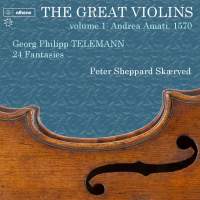Texte paru dans: / Appeared in: |
|
|
Outil de traduction ~ (Très approximatif) |
|
|
Reviewer: Robert
Maxham Peter Sheppard Skærved claims to have recorded Telemann’s violin fantasies in 1992 and to be returning to them, on a “period instrument,” in the first volume of Athene’s projected series devoted to “The Great Violins.” The “great violin” he employs for this reading, made by Andrea Amati in 1570, seems to be fitted with gut strings but, if the picture isn’t misleading, has been re-necked, so its set-up represents a sort of hybrid (and he tunes it to A=416, one vibration per second higher of the usual A=415 so often used in the period’s music). The Genoese Antonino Airenti made the bow. Skærved’s lengthy notes mention the composer’s classical education, and Skærved himself often displays this kind of academicism (some might feel a bit ostentatiously and devoid of self-deprecatory humor) not only in his booklet notes but in his playing itself. In the First Fantasie, for example, he at times seems to allow the flow of the rhythm to become interrupted by rhetorical devices. This kind of seeming stumbling also occurs in the movements da chiesa, for example in the fugal Presto, the central movement of the Third Fantasie. Nevertheless, his notes make it clear that he’s aware of the rhythmic difficulty of playing syncopation when there’s no explicit beat against which against which to syncopate. On the other hand, he draws an imposing range of timbres from the Amati violin, such that many who might be put off by the manner will be attracted by the matter. Sometimes his violin sounds wind-like; and Skærved’s notes refer to what he’s learned from wind players in his performance of Telemann’s Flute Fantasies, also included in the set (though writers also often remark on the interchangeability of violin and trumpet in very early church music). There can be no reservations, either, about his performance of brilliant movements, such as the opening one of the Fifth Fantasie or his affinity for the chromatic diversions in movements like what he describes as the austerely fugal Presto of the Sixth. On the other hand, sometimes his effects can seem precious, as in the super-subtilized dialogue with himself in the Largo of the Seventh Fantasie. Balance with this the ruddy earthiness of his playing in the Allegro of the Fourth Fantasie. Between the extremes of the expressively convoluted Andrew Manze (Harmonia Mundi France 907137, which I sent to the head of the class in Fanfare 19:5) on period instruments and the more cheerful and open-handed Arthur Grumiaux (Philips Eloquence 8291, Fanfare 31:4) on modern ones, listeners might expect Skærved to fall on the period-instrument side—as to be sure he does, at least timbrally and stylistically. Whether or not Skærved’s personal way exercises an effect similar to readings of the standard repertoire by, say, Jascha Heifetz and Zino Francescatti, may be arguable; but given the plethora of fungible performances by fungible (or worse, simply mannered) artists, Skærved’s individuality, whatever form it might take and whatever effect it might have, should be most welcome. The Flute Fantasies don’t, of course, employ double-stops, but in other ways, at least at the outset, they sound very violinistic in Skærved’s performance, from the very first measures of the First Fantasie’s opening Vivace. There’s plenty of rhythmic fantasy, too, as in the Vivace of the Second Fantasie; but eventually, the lack of violinistic figuration and signature double-stops does render the fantasies progressively less violinistic-sounding when heard ad seriatim. Slower movements such as the Andante of the Fourth Fantasie, however, to which such adornment as double-stops might arguably be less relevant to the expressive effect, seem more generically instrumental. Be that all as it may, into the ethnic-sounding second Allegro of the Fifth Fantasie, Skærved introduces several octaves and even a sort of ornamental double stop. He does so again, rather spikily this time, in both the Alla Francese of the Seventh Fantasie and the succeeding movement, as well as more fleetingly elsewhere. On the whole, Skærved plays the flute pieces with fewer expressive indulgences than he entertains in the ones for violin, and listeners who decry some of the things he attempts there may be mollified by his approach here. The recorded sound in the Church of St. John the Baptist in Aldbury allows a majestically prolonged decay of Skærved’s trumpet-like utterances. (Will captious purists question whether this ambiance might be inauthentic?). Principally for the ambiance, the tonal splendor of the Amati violin, and for the strong sense of purpose Skærved displays throughout, these performances earn a warm recommendation, even for collections that already include several staple versions of the Violin Fantasies.
| |
|
|
|
|
Cliquez l'un ou l'autre
bouton pour découvrir bien d'autres critiques de CD |
|




